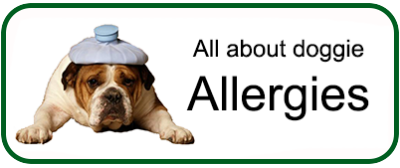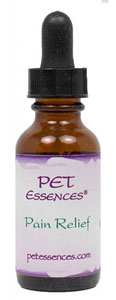Are mange mites causing your dog to itch?
What is mange? |
Demodex mange mites |
Sarcoptes mange mites
So what exactly is Demodicosis? |
Causes of demodicosis? |
Localised demodicosis
Generalised demodicosis |
What are the Symptoms of demodicosis?
How is demodicosis diagnosed? |
How is sarcoptic mange treated?
Outlook for dogs with demodicosis |
Canine Scabies (Sarcoptic Mange)
What causes sarcoptic mange? |
How is sarcoptic mange treated?
Long term outlook for dogs with sarcoptic mange?

What is Mange?
Mange is a term that is often misused by dog owners to describe any kind of itchy skin and in particular dogs which have a mangy look, usually brought on by a flea type allergy called dermatitis.

True mange however, is a condition caused by mange mites which burrow into dogs' skin and cause:
There are two types of mange mites which cause mange disease in dogs, these are "demodex mites" and "sarcoptes mites". Fortunately, they can both be kept at bay by the same treatment. I use a small round Flea and Tick Tag clipped to Molly and Rosies' collars. I use them as name discs as well, even though both girls are microchipped.
Demodex mange mites
These are the most common type of mites, and they are responsible for causing a skin disease known as "demodicosis" or "demodectic mange", also commonly referred to "red manage". The condition involves:
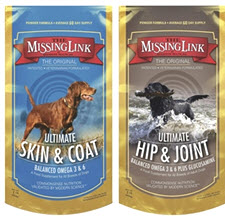
Sarcoptes mange mites
These mites occur less frequently than the demodex mites and the type of mange they cause is called "sarcoptic mange" or "canine scabies".
So what exactly is Demodicosis?
Demodicosis or "red mange" is an itchy inflammatory, parasitic skin disease that is caused by a large infestation of mites, which live in the hair follicles of dogs.
Normally red mange mites (demodex canis), are present in small numbers in most dogs, without causing any problems. It is only when mite population explodes beyond the control of dogs' imune systems that an inflammatory reaction develops.
Causes demodicosis?
The exact cause of demodicosis is not known, although one commonly accepted line of thought is that there may be genetic connection with regard to dogs' immune systems disorders.
There are two forms of demodicosis affect dogs - "localised" and "generalised".
Localised demodicosis
Localised demodicois sometimes develops in young dogs of less than one year old and generally presents before the dogs immune systems reache full maturity.
In most cases only small patches of hair loss is apparent and it is generally localised on the face and or legs, hence its name of localised demodicosis. About 90% of all cases resolve without treatment and the remainder progress to the generalised form.
Generalised demodicosis

Generalised demodicosis is a severe disease affecting many areas of the skin, particularly in adult dogs. The condition is often associated with:
- Cancers
- Immuno-suppressive disorders
- Other internal diseases
In adolescent dogs with generalised demodicosis an inherited immunological disorder is suspected, in which case it is a good idea not to breed with the affected dogs.
What are the Symptoms of demodicosis?
Localised demodicosis is always characterised by patches of mild redness and scaling, primarily located on the face around the ears and eyes.
The same kind of patches may occasionally be found on a dog's legs and trunk region.
Generalized demodicosis is always characterised by:
Mites cause hair follicles to distend and rupture, which predisposes the dog to the development of secondary bacterial skin infections.
If not treated the skin becomes extremely inflamed and fluid may ooze from the infected patches.
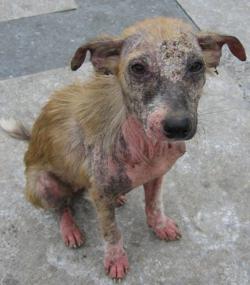
What are the Symptoms of demodicosis?
Demodicosis is diagnosed by physical examination and the dog's medical history. Skin scrapings must be taken from the dog to look for eggs, mites and larvae under a microscope.
The skin scraping must be deep to enable correct diagnosis and blood may be produced at the scrape site during or after the sample is taken. In dogs with chronic demodicosis, a skin sample may be required to identify the mites under a microscope. This biopsy would need to be surgically removed.
How is sarcoptic mange treated?
Genererally speaking treatment for localised demodicosis is not required since the disease is thought to resolve by itself in most cases (approximately 90%).
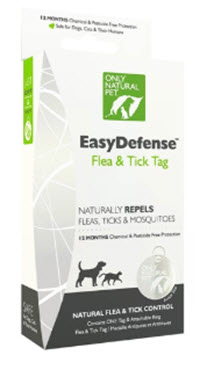
However, long-term treatment is required for generalised demodicosis. In most dogs with generalised demodicosis, the condition is kept under control rather than cured.
Generalized demodicosis is an extremely frustrating disease for dog owners and veterinarians. Treatment usually involves:
- Clip your dog as close as possible to his or her skin, it is important to remove all stages of mite off-spring
- Repeated applications of specialised Shampoo and Conditioner
- Apple cider vinegar with Mother sponge-bath can help get rid of the mange mites. Mix ½ cup of apple cider vinegar with ½ cup of Borax and warm water. Be sure the Borax is fully dissolved before sponging the mixture on to your dog's skin and coat. Also make sure your dog does not lick the mixture, as ingesting Borax can be extremely harmful
- Topical application of antiparasitic Creams or Lotions
- Oral Administration of Antiparasitic Compounds
- Antiparasitic Sprays
- Parasitic Collar Tag
Your vet will need to examine multiple skin scrapings at regular intervals in order to monitor your dog's response to treatment. You can expect 8 to 12 weeks of treatment, sometimes a little longer, to bring the condition under control.
What is the long term outlook for dogs with demodicosis?
The prognosis for dogs with demodicosis varies from dog to dog depending on the degree of exposure. Generally the long term out look for dogs with localised demodicosis is good.
Canine Scabies (Sarcoptic Mange)
What is sarcoptic mange?
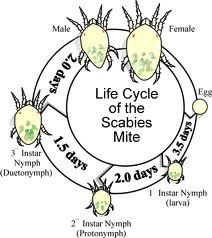
Sarcoptic mange or canine scabies is a highly contagious, parasitic skin disease found in dogs. It is a disorder caused by the infestation of sarcoptic mange mites which burrow through the upper surface layer of the skin and cause intense itching, irritation and scratching.
The mites secrete substances called allergens that produce an allergic or hypersensitivity reaction in infected dogs.
What causes sarcoptic mange?
Sarcoptic mange is a contagious disease and infestations of the mite is caused by exposure to another dog suffering from sarcoptic mange. Stray dogs and dogs living outside are potential carriers of the disease.
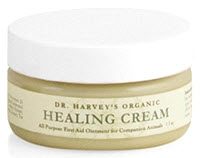
Anywhere where dogs are gathered en masse are likely places for a dog to pick up sarcoptic mange mites e.g. local dog pounds, grooming facilities or even veterinarian clinics. In Australia, foxes and wombats are also potential sources of infection.
Sarcoptic mange mites are "zoonotic", which means they can be passed on to the dog's human family members. People who have been infected with sarcoptic mange mites will develop an itchy rash with small raised papules or bumps on their chest, arms or abdomen.
Rashes in humans usually are temporary and should disappear after the affected dog has received treatment. Anyone who suspects they have sarcoptic mange should contact their doctor for treatment.
What are the symptoms of sarcoptic mange?

Sarcoptic mange or canine scabies is a very itchy skin condition. Dogs will have red rashes together with hair loss. Generally the signs and symptoms are seen on the hocks, elbows, chests and abdomens. Scaling and crusting may be present on the ears as well.
Initially dogs scratch, this leads to sores on their skin and if not treated pus filled lesions may form - in severe cases infection can spread to dogs lymph nodes.
How is sarcoptic mange treated?
There are a number of treatments available for treating sarcoptic mange effectively. Most of which we have already covered above under How is demodicosis treated?
It is always best to seek the advice of your veterinarian as to which treatment is best suited for your dog, particularly if the condition has progressed to the point of requiring prescribed medications such as corticosteroids or antibiotics.
Long term outlook for dogs with sarcoptic mange?
With the correct treatment, the prognosis for dogs with sarcoptic mange mites is pretty good. They should respond to treatment within two to three weeks, although treatment will need to be continued for two weeks beyond remission of signs.
This article and information forms part of the Carole's Doggie World Holistic Library and is presented for informational purposes only.The information is not intended to be a substitute for visits to your local vet. Instead, the content offers the reader information researched and written by Carole Curtis for www.carolesdoggieworld.com

